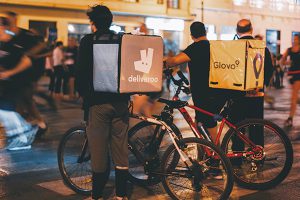Inflation is coming for consumers’ pricey pandemic habits.
Whether choosing restaurant dinners delivered to their door or at-home meal kits, many Americans have prioritised convenience over cost for the past two years. Food-delivery was a big beneficiary. Some of the top platforms including DoorDash Inc and Uber Eats enjoyed triple-digit growth rates, supercharged by Covid fears and the suspension of restaurant dining. Similarly, meal-kit provider Blue Apron Holdings Inc was struggling before the pandemic and considering putting itself up for sale. But when the virus hit, thousands of customers flocked to its service.
Now accelerating inflation, combined with easing fears about eating in restaurants as Covid cases drop, threaten to deflate the delivery boom. Inflation
in particular is likely to prompt consumers to re-evaluate their spending and look to trim outlays they deem less than essential. And many could decide that having home delivery multiple times a month or ordering ice cream on the spur of the moment from a fast grocery service like Gorillas could be given up without too much disruption to daily life.
Already, fewer Americans report ordering takeout for delivery, according to the most recent monthly survey of food and beverage habits by Morning Consult. It doesn’t help that these services are getting more expensive. For a start, food inflation will elevate costs at restaurants that use services like Just Eat Takeaway.com NV’s Grubhub for deliveries. The average check across restaurants, takeout and home delivery rose 7% in 2021 compared with 2020, according to data provider NPD Group.
The increase in gasoline prices prompted Uber Technologies Inc to impose a
surcharge on Uber Eats deliveries to ease the pain on drivers, which adds to the cost for consumers. Grubhub also has raised driver pay, which is likely to be reflected in the fees it charges customers. Hello Fresh is tweaking prices in some markets for its meal kits, which already are more expensive than buying groceries or a ready meal that can be popped in the microwave. Last fall, Blue Apron added a flat $9.99 shipping fee to its boxes, and updated its pricing structure in response to higher costs.
What’s more, there are other choices available, such as buying a meal from a value player such as Chipotle Mexican Grill Inc. Morning Consult found that ordering takeout for pickup has remained more stable than other categories.
Americans also could simply take a trip to the grocery store. While food retailers face their own cost challenges, they are positioning themselves to benefit from consumers trading down.
Supermarket giant Kroger Co said it was seeing more people cook at home because it was cheaper than other dining options. It is also one of the companies, alongside Walmart Inc and Amazon.com Inc’s Whole Foods, that have been investing in meal kits. Kroger acquired Home Chef in 2018. It now generates $1 billion in annual sales.
Meal delivery and meal kit services do have one feature that could help insulate them from an inflation pullback: People using them tend to be younger and more affluent and thus more able to deal with rising costs.
And as budgets are squeezed, some consumers might find that they spend less when having food delivered than when going out to restaurants. Even so, as Walmart noted last month, in periods of inflation, all income tiers become more price-sensitive.
—Bloomberg
 The Gulf Time Newspaper One of the finest business newspapers in the UAE brought to you by our professional writers and editors.
The Gulf Time Newspaper One of the finest business newspapers in the UAE brought to you by our professional writers and editors.
